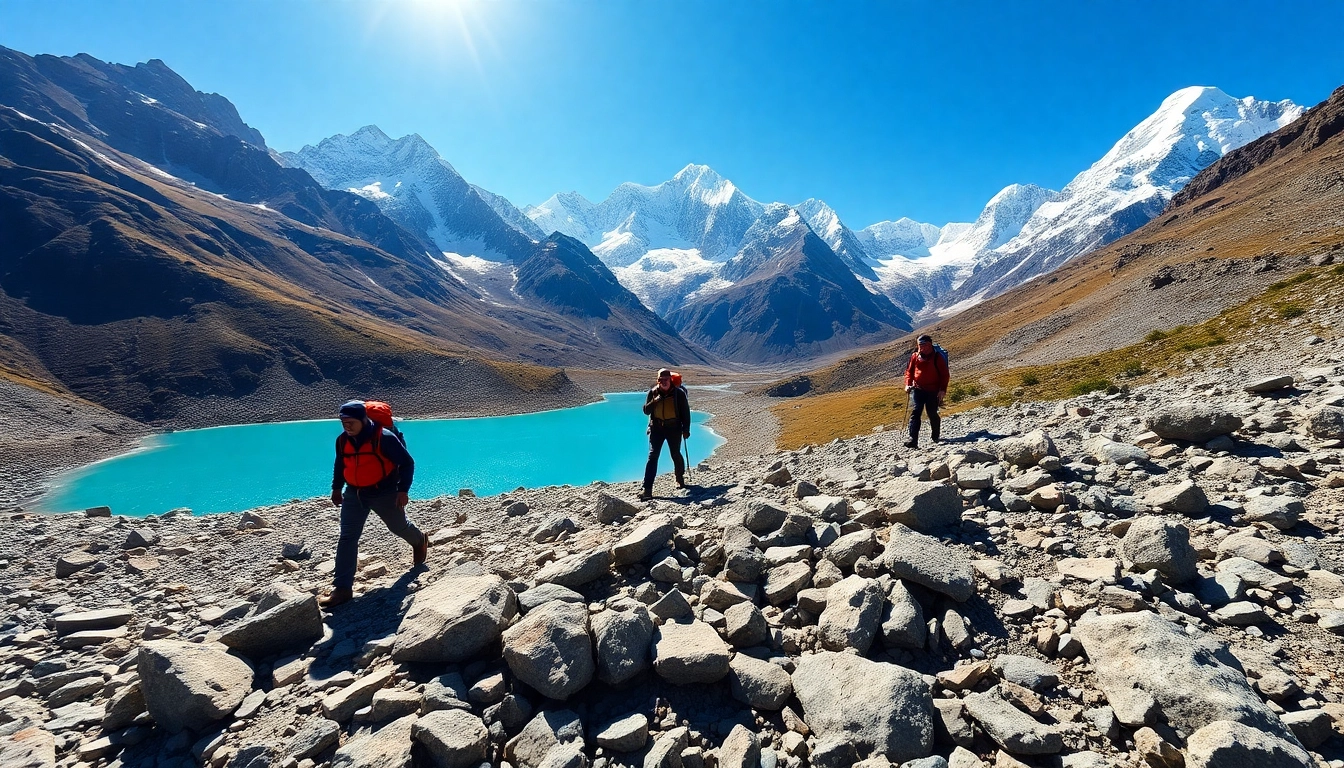An Overview of Everest Base Camp via Gokyo Lakes Trek
Embarking on the Everest Base Camp via Gokyo Lakes Trek is not just another adventure; it’s a transformative journey that takes you deep into the heart of the Nepalese Himalayas. This trek offers a unique blend of breathtaking landscapes, rich cultural encounters with the Sherpa community, and the exhilarating challenge of high-altitude hiking. While many adventurers aim for the iconic Everest Base Camp, the journey through Gokyo Lakes provides an alternative route that is just as magnificent, filled with stunning views and exhilarating experiences.
What to Expect on Your Trek
Trekking to Everest Base Camp through Gokyo Lakes is marked by diverse landscapes and varying terrain, and includes navigating the rugged trails that offer some of the most breathtaking scenery in the world. Expect to traverse lush valleys, cross high mountain passes like the Cho La Pass, and walk alongside turquoise glacial lakes. Each day of trekking unveils spectacular panoramas that range from rolling green hills to towering snow-capped peaks.
Throughout the trek, trekkers will encounter quaint tea houses, meet local Sherpa families, and immerse themselves in the unique culture of the region. The experience emphasizes not just the physical aspect of trekking but also connects you with centuries-old traditions, allowing for a richer understanding of this incredible landscape and its people.
Key Attractions Along the Route
Several key attractions make this trek stand out:
- Gokyo Lakes: A series of stunning turquoise lakes surrounded by towering peaks, the Gokyo Lakes are considered to be some of the most beautiful in the world.
- Cho La Pass: Standing at 5,420 meters, crossing this pass is a challenge but offers awe-inspiring views of both the Gokyo Valley and the Khumbu region.
- Gokyo Ri: This peak offers climbers a sweeping panoramic view of Everest and the surrounding peaks, making it a must-visit.
- Nepalese Culture: Experience the Sherpa culture through local villages, ancient monasteries, and hospitality offered by the local inhabitants.
Preparing for the Everest Base Camp via Gokyo Lakes Trek
Essential Gear and Supplies
Proper preparation is essential for a successful trek. Choosing the right gear can significantly affect your experience, providing comfort and safety throughout the journey. Key items to include:
- Hiking Boots: Sturdy, waterproof boots with good traction are critical for navigating diverse terrains.
- Clothing Layers: Base layers, insulating layers, and outer shells will help regulate temperature and manage moisture.
- Sleeping Bags: An insulated sleeping bag rated for extreme conditions is essential for overnight comfort.
- Water Purification System: Staying hydrated is crucial, so a reliable water filtration system helps ensure access to safe drinking water.
- First Aid Kit: A comprehensive first aid kit is vital for addressing minor injuries and altitude sickness symptoms.
Physical Preparation and Training Tips
Preparing physically for the Everest Base Camp via Gokyo Lakes Trek is crucial given the taxing nature of the climb. Key training components include:
- Cardiovascular Training: Engage in activities such as running, cycling, or swimming to build endurance.
- Strength Training: Focus on lower body workouts to strengthen your legs, core, and back.
- Altitude Simulation: If possible, train at higher altitudes or use altitude training masks to simulate the conditions.
- Practice Hikes: Take shorter multi-day hikes to condition your body to carry a backpack and to hike on uneven terrains.
Understanding Weather and Conditions
The weather conditions in the Everest region can be unpredictable. Typical trekking seasons are pre-monsoon (March to May) and post-monsoon (September to November). Nonetheless, it is essential to monitor weather forecasts and be prepared for sudden changes. Key considerations include:
- Temperature Drops: Nights can be extremely cold; dressing in layers and carrying warm gear is essential.
- Rain and Snow: Afternoon rain or snow can occur, so waterproof gear is recommended.
- Wind Conditions: Wind at higher altitudes can be fierce; find the right clothing to protect against cold winds.
Navigating the Gokyo Lakes and Cho La Pass
Trail Details: Routes and Distances
The trek to Everest Base Camp via Gokyo Lakes generally spans about 135 kilometers (84 miles), with several variations depending on detours and side hikes. Here’s a breakdown of the key stages:
- Lukla to Gokyo: This leg typically takes 5-7 days, during which trekkers cover portions of the route that showcase Gokyo Lakes.
- Gokyo to Cho La Pass: The ascent towards Cho La Pass brings the immense challenge of navigating high-altitude terrain.
- Cho La to Everest Base Camp: This segment can be strenuous, but ultimately leads you to the dramatic views of Everest Base Camp.
Crossing Cho La Pass: Tips and Challenges
Crossing Cho La Pass is one of the most exhilarating and challenging parts of the trek. Here are some tips to help manage the crossing effectively:
- Start Early: Begin your ascent early in the morning to avoid the midday heat and give ample time for the trek.
- Stay Hydrated: Keep hydrated throughout the climb, as altitude can dehydrate you faster than at lower elevations.
- Take Breaks: Regularly scheduled rests allow your body to adjust to the altitude and help prevent exhaustion.
- Use Trekking Poles: Poles can provide stability on uneven terrain and help to reduce strain on your knees during descent.
How to Safely Enjoy the Gokyo Lakes
The Gokyo Lakes are a highlight of the trek, offering stunning views that are worth enjoying responsibly. Safety tips include:
- Stick to Designated Trails: To preserve the environment and ensure personal safety, always remain on marked trails.
- Manage Altitude Sickness: Pay attention to your body and descend if you start to feel unwell.
- Engage Local Guides: Experienced guides can enhance your understanding of the local environment and culture, ensuring a fulfilling experience.
Cultural Insights and Local Communities
Meet the Sherpa People: Culture and Traditions
A trek through this region immerses you in the rich culture of the Sherpa people, known for their remarkable mountaineering skills and hospitality. Visitors often have the opportunity to learn about:
- Spiritual Beliefs: A blend of Buddhism and animism defines Sherpa spirituality, with sacred practices deeply connected to monitoring the mountain environment.
- Community Life: Life revolves around the land, and trekking allows for direct interactions that reveal their traditional agricultural practices and local economies.
- Festivals and Celebrations: If you time your trek right, you might participate in a local festival, characterized by music, dance, and traditional food.
Exploring Local Cuisine on the Trail
Exploring local flavors adds another layer to the trekking adventure. Highlights of Sherpa cuisine include:
- Dhalbhat: A traditional meal, consisting of rice, lentil soup, and vegetable curries.
- Thukpa: A warming noodle soup ideal for cold weather, rich in flavor and nutrition.
- Churpi: Dried cheese that serves as a staple snack for many Sherpas, often enjoyed alongside butter tea.
Interacting with Local Guides and Porters
Building relationships with local guides and porters enriches the trekking experience. They offer invaluable insights into the region and provide not only guidance but a connection to the local culture. Here’s how to foster a positive interaction:
- Show Respect: Understand and appreciate cultural norms and practices.
- Encourage Local Communities: Support local businesses by purchasing goods and meals from local shops and eateries.
- Listen and Learn: Take the opportunity to learn about their personal stories, traditions, and the profound connection they have with the mountains.
Staying Safe During Your Trek
Altitude Sickness: Signs and Prevention
Altitude sickness is a genuine concern when trekking at high elevations. Recognizing the signs and taking preventive measures is crucial. Signs include headaches, nausea, dizziness, and fatigue.
To prevent altitude sickness:
- Ascend Gradually: Give your body time to acclimatize to higher altitudes, increasing elevation slowly.
- Hydrate Regularly: Drinking plenty of water is essential to utilize oxygen efficiently at altitude.
- Understand Your Body’s Limits: If you experience severe symptoms, descend immediately and seek medical attention if necessary.
Safety Tips for Trekking in Remote Areas
Safety in remote areas requires planning and awareness. Here are some best practices:
- Travel in Groups: Group trekking provides safety in numbers, making it easier to manage emergencies.
- Stay Informed: Keep up to date with local weather conditions and trailforecasts to anticipate any changes.
- Emergency Communication: Carry reliable communication devices, such as a satellite phone, to keep in contact with the outside world.
Emergency Procedures and Communication
In the event of an emergency, knowing how to respond is vital:
- Establish a Plan: Familiarize yourself with local emergency numbers and know the location of the nearest medical facility.
- Emergency Contact: Share your itinerary with a trusted friend or family member back home.
- Stay Calm: In a crisis, remaining calm allows you to think clearly and act rationally.



